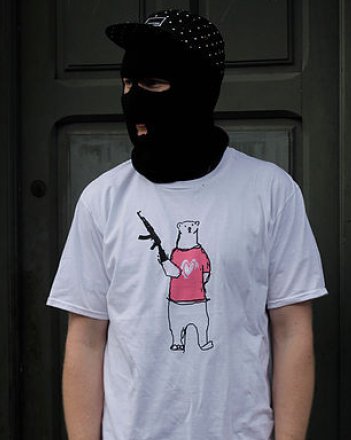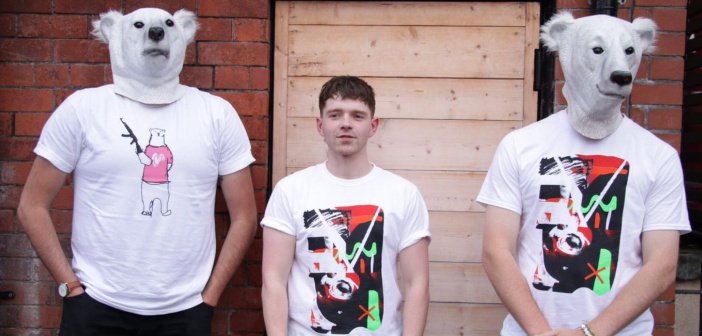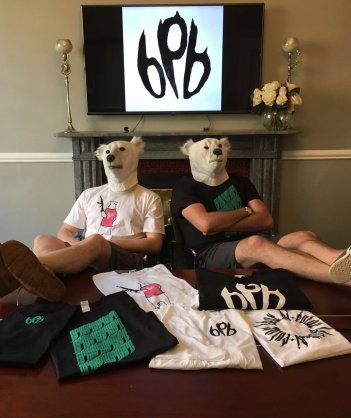BiPolar Bear Wear | Doing Good While Looking Good
I meet Stephen Considine, Cameron Ridyard and Luke Bulmer, the founders of the clothing line BiPolar Bear Wear in a Dublin city-centre café instead of in their premises for one simple reason: they don’t have one. Instead, the clothing line is sold and marketed online, with stock stored in Luke’s house and meetings held via group chats on WhatsApp.
BiPolar Bear began in June 2016, as a company with a mission to inspire their 18-30 year-old target demographic to start talking about mental health. The clothing line was something that they had talked about for years, says Luke, with Cameron adding that it was all about “creating something for us, but also giving back.” Stephen sums up their ethos: “Clothes that make the world a better place.”
Mental health in Ireland

According to a 2013 study conducted by the Royal College of Surgeons in Ireland, one in five people between the ages of 19-24 suffer from or have experienced a mental disorder. In 2006, the HSE released a document entitled A Vision for Change, which set out a plan of action for mental health services in Ireland.
The main vision of the report was that “Each citizen should have access to local, specialised and comprehensive mental health service provision that is of the highest standard.”
In a June 2016 report which revisited A Vision for Change, it was found that “while this report documents a lot of activity related to recommendations in A Vision for Change, there is no doubt that the mental health system set out by the Expert Group has yet to be realised across the country.” The report concluded that this was largely due to how “primary care mental health services remain under-resourced and uncoordinated with mental health services,” which leads to “significant social exclusion” for people with mental health issues.
Stigmatisation of mental health
The three founders of BiPolar Bear have individually had various issues with mental health, primarily ADHD and depression. Out of these experiences came a desire to reduce the stigma around mental health problems, and to encourage their peers to feel as comfortable discussing mental illness as they would with any physical illness.
The plan is to “build a brand that’s really cool” and influence kids through leading by example, says Cameron. “Your hair, your clothes and your runners say the most about you,” is Stephen’s opinion, and the BPB sweaters are a way to show you’re willing to talk about mental illness. They’ve found their friends have responded to their open dialogue about the issue. “I opened up with my mates on group chat,” says Luke and the conversation started. “If I can do that with a text message…”
The meaning of the BiPolar Bear
The usage of the word “bipolar” has three meanings, Stephen tells me, meaning that the title is “always open to interpretation.” These meanings are: a polar bear from both poles, a bisexual polar bear, and a bear with bipolar disorder.

The usage of puns sums up the company’s attitude to approaching mental health with humour. “Our concept is to make being bipolar, or any other mental health issue, már shampla depression, as common as a head flu to talk about, thus eliminating some of the stigma surrounding any mental health,” says Stephen.
While the three men don’t suffer from bipolar disorder themselves, they believe the concept of humour along with their practical approaches to helping improve mental health among young people justifies the use of the pun.
“The other strategy for any one that might feel the title is ‘bipolar bear’ is unfair, is to help anyone that is bipolar, by donating all profit from BPB Wear to a mental health charity,” continues Stephen.
The beginnings of BPB
The push to set up the line came about as the result of Cameron and Stephen graduating from NCAD in 2014 in the midst of repercussions from the recession, and bonding with Luke over the struggle to find creative work.

Bipolar Bear seems to quintessentially sum up Generation Y (generally speaking, those born in the 1980s and 1990s) in this sense, especially when Cameron describes the founding of the brand as “three lads, bored with the standard mid-twenties crisis.” Their intent of “doing good” is part of a mission statement that exists in a group chat in Whatsapp and is adaptable, rather than a set of rigid rules.
When it comes to marketing themselves, they work through Snapchat, Instagram and Twitter, which they use to educate their audience about the importance of addressing mental health issues as well as advertising their designs.
The brand exists as something of an antithesis to the capitalist model and world, which Cameron believes “has been turning and turning and now it’s going to break.”
The founders will consider the brand a financial success when they can afford to hire a new employee, something they plan to do before taking a salary for themselves. When asked what this hypothetical employee would do, the lads laugh and throw around various skills like web design, accounting, embroidery and “basically everything.”
Luke, who currently takes care of the website orders, day-to-day business, and uses his house as storage space for their stock tells me how this is an opportunity they don’t want to waste. Ultimately, they want to sell bags, hats and “everything,” to create something that they are proud of. Luke is certain that this will happen: “I think we’ll end up with what we want,” he says confidently.
“Doing good”
Sentiments of wanting to do good things for the world are nice, but what are BiPolar Bear actually doing to achieve this?
Firstly, there are the clothes themselves. Cameron tells me that they made sure to find an ethical supplier of the T-shirts and jumpers, which they felt comfortable using.

Secondly, there are the limited edition “AWEAR” T-shirts, where an invited artist creates a design and 100% of the profits go to a designated mental health charity. The first charity that benefit is St. Patrick’s Mental Health Services, from a T-shirt designed by Neil Dunne.
The decision to choose this service stems from personal experience, as it was in mental health facilities that Stephen discovered art therapy, which he cites as his favourite part of the week during his stay, despite the fact only an hour a week was provided. He’s not sure that the mental health services in Ireland realise the importance of creativity, which is something all three founders want to emphasise.
The third way they are “doing good,” is through the use of art therapy. Ultimately, they want to fund an art therapy centre. Until then, they are looking to host events, and have committed to teaching art therapy classes in colleges throughout the country, with a number already confirmed for various different colleges’ respective mental health awareness weeks.
These specific practices are part of a general commitment to foster awareness, with a usage of their social media channels to direct those who are struggling and have contacted them for advice towards services such as Samaritans and St. Patrick’s.
While they’re heavily invested in social media, they also value the importance of real-life experiences – Stephen tells me about his plans to start hosting day trips such as mountain hikes in Glendalough in the hopes that this will show them “the beauty of the world.”
As we finish up the interview, I ask them what seems to me an obvious question: are they looking to form a community? There’s a pause while they look at each other, before Cameron answers: “I guess we hadn’t thought of it like that, but yeah.”
